 Everybody loves a good story!
Everybody loves a good story!
Discover the heart-warming tales of Hickory Knolls from Harley the hawk on a short hike through the natural area as he takes his friend, Greta the Grasshopper, on an exciting adventure.
Harley’s family has lived in the Fox Valley area for generations, and he has some great insight as to how the land and environment have changed over the years.
The walk begins on the trail across the road, west of the garden plots. Look for the Andrini Trail sign to find the start. The first story board is down the path. The entire story walk is an estimated 3/4-mile. Inner loop story walk is about 1/2-mile. Dress appropriately for the weather.
It’s best to read the story on site to acquire an actual sense and feel of the adventure while outside with all the elements, but for those who wish to view it online, click on the storyboard image.
For a PDF version: click here
For a storyboard map: click here
Harley’s Story wHoo’s wHoo…
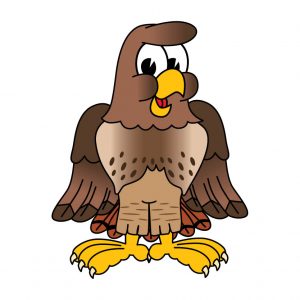 |
Harley the Red-tailed hawkLike his family before him, Harley rules the skies over Hickory Knolls. His sharp eyesight lets him see a mouse from 100 feet in the air and his strong wings help him fly at speeds up to 40 mph. He and his mate can often be seen perching in the cottonwood trees near the first hill as you enter the natural area. Look for their large nest, made of sticks, as you hike the trails. |
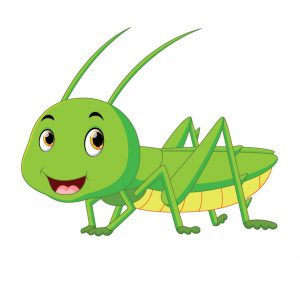 |
Greta the grasshopperGreta is quite chatty in our story, but actually is a good listener too. Female grasshoppers have ears, not on their heads, but on the front part of their abdomen. They listen for the calls of the males of their species. The males can make sound either by rattling their wings in flight (crepitation), or by rubbing their legs against their wings (stridulation). |
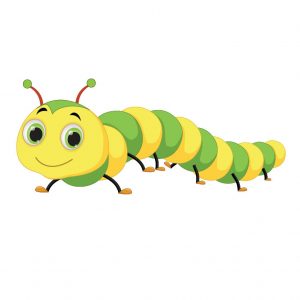 |
Callie the monarch caterpillarEven though she’s absent for much of the story, Callie is the star of Harley and Greta’s adventure. She began her life as an egg, then fed on milkweed plants and molted several times before she reached the time to shed her skin one last time and form a chrysalis. There she begins her miraculous transformation in a butterfly, a process that takes 10 days to two weeks. |
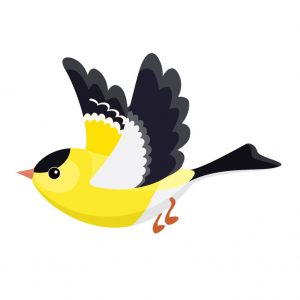 |
Aaron the American goldfinchSome people call Aaron a wild canary due to his bright yellow color, and they wouldn’t be too far off. American goldfinches belong to the same family as canaries, the Fringillidae. In summer, listen for Aaron’s musical song as well as the call he gives in flight, which sounds like “potato chip, potato chip.” You can find Aaron in winter too, but at that time of year he wears colors that are drab, much like those of his mate. |
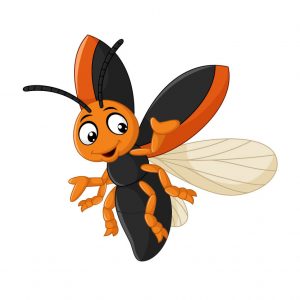 |
Dottie the diurnal lightning bugDottie’s flashy relatives get all the attention in summertime, but she is an important member of the Lampyridae, the lightning bug or firefly family. Although she does not produce light as an adult, when she was a young larva she glowed. All lightning bug larvae live in the ground and feed on other insects but as adults they sip nectar and pollen, if they feed at all. |
 |
Cora the coyoteJust about everyone has heard of coyotes, but hardly anyone really understands these mysterious creatures. Although they have a reputation of being carnivores, coyotes actually are omnivores and eat a variety of plants and animals. In summertime their diet can be almost 100% plant-based because that’s when fruits like berries are plentiful. |
 |
Sammy the squirrelHickory Knolls is home to both fox squirrels and gray squirrels. Fox squirrels have an orange underside and are larger, averaging around 2 lbs.; gray squirrels are smaller, around 1 lb., and have white underneath. As rodents, they feed on plant material, including fruits and nuts. They build leafy nests in trees but also will live in tree cavities. At any one time, most squirrels have at least two nests they call home. |
 |
Chucky the chipmunkChucky belongs to the same family as Sammy, which is the Sciuridae, or squirrel family. But rather than nesting in trees, Chucky digs an extensive home underneath the ground. His burrow can have many chambers, including spaces for sleeping, storing food and going to the bathroom. He needs all those rooms because chipmunks stay in their burrows all winter long. |
 |
Spencer the spring peeperSpring peepers are about 1 ½ in. long and tan or brown in color with a telltale X on their back. They are named for the peeping sound of their call. Like chorus frogs, spring peepers mate and lay their eggs in wetlands and then disperse. Their tadpoles feed on aquatic plants and need about eight to 10 weeks to transform into frogs. |
 |
Colin the chorus frogChorus frogs measure about 1 in. in length and are tan or brown with three dark stripes running down their back. Colin and his friends are the loudest frogs in the wetlands. In springtime, after mating and laying eggs in water, the frogs disperse and head into the shaded woodlands where they can stay cool and moist. Like all frogs, they hibernate in winter. |
 |
Norman the northern leopard frogNorthern leopard frogs are 3 to 5 in. in length and are named for the dark spots their green skin. Their long, strong legs help them travel great distances from the wetlands where their eggs were laid. As long as they can avoid direct sunlight and drying winds, they survive just fine. As an adult, Norman feeds on insects, as do Spencer and Colin and in fact all frogs. |
 |
Ginny the ground-nesting beeGinny represents the dozens of species of native bees that live at Hickory Knolls. She is green, which tells us she is part of the Halictidae, or sweat bee family, and is quite small, about ½ in. in length. But native bees come in many colors and sizes and include fuzzy bumblebees, mason bees and leafcutter bees. They are important pollinators of our native wildflowers. With the exception of bumblebees, our native bees are solitary; they live by themselves and do not produce honey. |
 |
Callie the monarch butterflyOnce a caterpillar, Callie ends up a beautiful butterfly. In real life, monarch butterflies raise three generations in our area. The final group, known as the super generation, in September takes off on a fabulous journey south to the mountains of Mexico. They spend the winter there, then in March begin their flight back north. In the southern United States they lay their eggs, which will supply the next generation of monarchs that continue the journey. Monarchs typically arrive back at Hickory Knolls in June. You can start looking for their caterpillars—the next Callies—in early July. |
This entertaining story, for young and old, was inspired by the travels of a Park Board Commissioner and developed by the District’s Nature and Marketing Departments.
